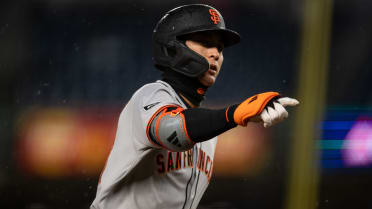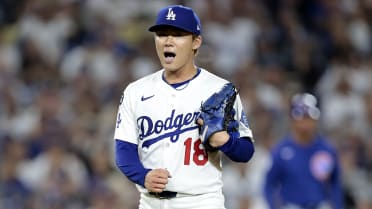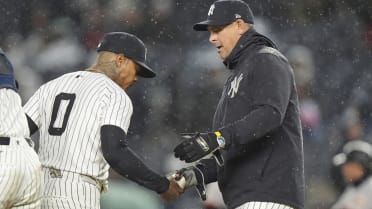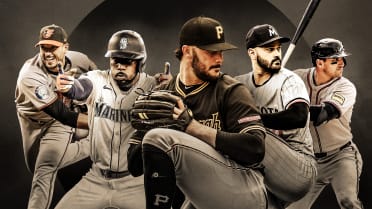The Phillies and Padres have taken very similar paths on their way to meeting in the National League Championship Series.
They secured the final two NL Wild Card berths to make the postseason, then each pulled off an upset on the road in the NL Wild Card Series. Both knocked off a 100-win rival in the NL Division Series, with the Phillies (87-75) eliminating the Braves (101-61) and the Padres (89-73) shocking the Dodgers (111-51).
Their rotations are built similarly. Their bullpens have steadied after a midseason lull. Each has a lineup anchored by a superstar, surrounded by plenty of offensive weapons.
So how will this series be decided? Let’s take a closer look.
How does each team play its aces?
Both clubs come into this series with not only its rotation lined up perfectly, but with some extra rest on top of it. And with both the Phillies (Zack Wheeler and Aaron Nola) and Padres (Yu Darvish and Blake Snell) carrying a pair of aces, either team could win the series simply by winning each of the four starts with its top two pitchers on the mound. That would seemingly be Games 1 and 5 (Wheeler vs. Darvish), as well as Games 2 and 6 (Nola vs. Snell).
That’s a tall order, especially when the other team is also rolling out its aces. And even if one team wins three of those four games, this matchup would still come down to what happens in those other three contests.
Both Philadelphia and San Diego have reliable No. 3 starters in Ranger Suárez and Joe Musgrove, respectively -- but this NLCS has an added wrinkle of playing Games 3-7 without a built-in off-day.
In past best-of-seven series, a Game 3 starter is typically available for Game 7 on normal rest, with the option of bringing back the Game 4 starter on short rest. In this series, however, the Game 3 starters (likely Suárez and Musgrove) would be pitching on short rest in an if-necessary Game 7.
So how would each team approach Game 7, if it comes to that?
Even if the clubs used Wheeler and Darvish on short rest in Game 4, they would have only two days off before Game 7, so that does them no good. If they stick with their normal No. 4 starter -- potentially Noah Syndergaard for the Phillies and Mike Clevinger for the Padres -- that eliminates each of them from a possible Game 7.
Thus, the Game 7 options for each team would seem to be either using its No. 3 starter (Suárez and Musgrove) on short rest, going with a player who hasn’t made a start this postseason (Bailey Falter or Kyle Gibson for the Phillies and Sean Manaea for the Padres), or a bullpen game.
"Thinking about it a little bit but not a whole lot, because we've got a couple games before that," Phillies manager Rob Thomson said of his club’s pitching plans. "Once we get through the off-day, we'll have to really think about that hard."
Of course, that situation can be avoided entirely if either team takes care of business with its studs on the mound.
Which co-star steals the show?
Bryce Harper is hitting .435 (10-for-23) with three homers, three doubles, six RBIs and a 1.437 OPS this postseason. Manny Machado went 5-for-14 (.357) with a home run and a 1.114 OPS in the Padres’ NLDS win over the Dodgers.
But advancing to the World Series will require contributions from the supporting cast.
For Philadelphia, Rhys Hoskins hit a series-shifting three-run homer in Game 3 of the NLDS against the Braves, and J.T. Realmuto added an electrifying inside-the-park homer in Game 4. But overall, Hoskins is just 4-for-26 (.154) this postseason. Kyle Schwarber, who led the NL with 46 home runs in the regular season, is just 1-for-20 (.050) with eight strikeouts and zero extra-base hits. Nick Castellanos is 5-for-23 (.217) with a .541 OPS.
For San Diego, Trent Grisham’s three home runs this postseason are tied with Harper for the NL lead. But Juan Soto has a .586 OPS in seven games this postseason. Wil Myers is 2-for-23 (.087) with 10 strikeouts. Brandon Drury, who had a career-high 28 homers this season, is 1-for-15 without an extra-base hit.
“We have a lot of guys that are taking over and helping us get to where we want to get to,” Machado said. “And whenever all 26 guys are contributing to a team, that makes it dangerous.”
This series will be decided far more by which of those co-stars rises to the occasion than Harper or Machado continuing to thrive on his own.
Can the Phillies’ bullpen keep up?
The regular-season numbers aren’t pretty for Philadelphia’s bullpen, but those can really be thrown out the window at this point. Seranthony Domínguez is finally healthy, and he’s pitching as well as he ever has for the Phillies.
“I’m back,” Domínguez said. “I’m definitely back.”
José Alvarado, who was demoted to the Minors after a rocky start to the season, has been lights out since returning on June 12. He has a 1.55 ERA over his past 30 appearances, including the postseason, and he has racked up 44 strikeouts -- and just eight walks -- over 29 innings during that span.
“He’s one of the best relievers in the world right now,” Domínguez said.
Zach Eflin’s transition to the bullpen has provided another significant boost for the Phils. David Robertson could be activated for the NLCS after missing the NLDS with a right calf strain.
All of those things have helped turn a perceived weakness into a relative strength for the Phillies. But on paper, the bullpen edge still goes to the Padres.
In the NLDS, San Diego’s relief corps allowed just one run over 16 innings against the Dodgers, the highest-scoring offense in the Majors during the regular season.
It certainly helps that Josh Hader has seemingly rediscovered his elite form, tossing 4 1/3 scoreless innings this postseason. Going back to the regular season, Hader has gone 14 straight outings without allowing an earned run. He has 20 strikeouts over 13 2/3 innings during that span, and he didn't allow multiple hits in any of those 14 outings.
The Phillies will need Domínguez and Co. to continue their resurgence to offset the Padres’ late-inning prowess.
Paul Casella is a reporter/editor for MLB.com based in Philadelphia.




